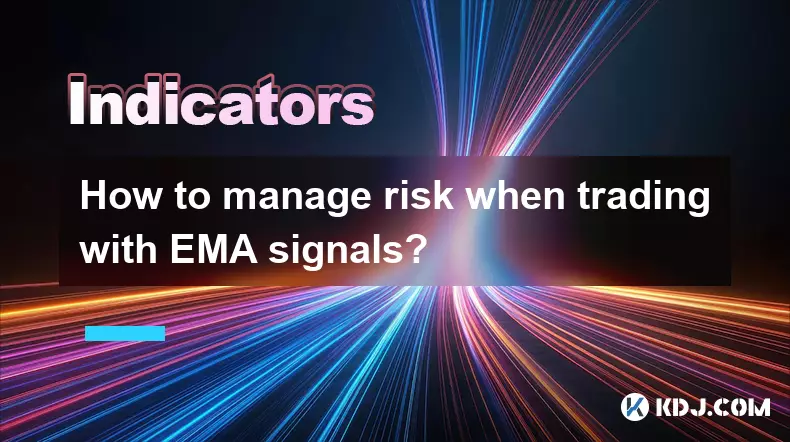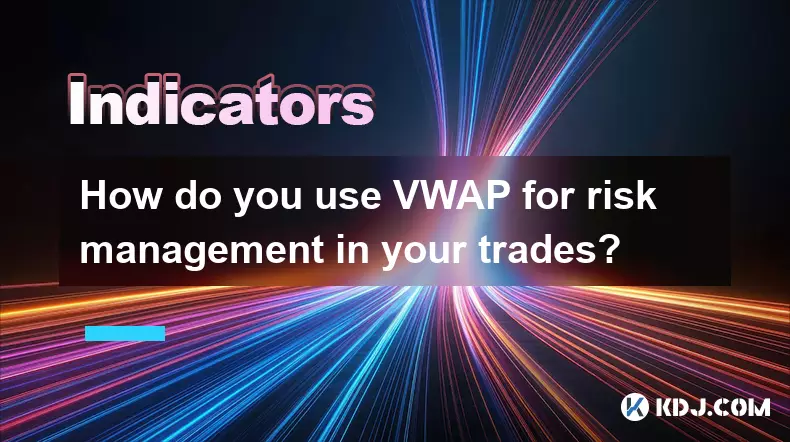-
 bitcoin
bitcoin $114684.631706 USD
-0.87% -
 ethereum
ethereum $4228.677447 USD
1.58% -
 bnb
bnb $1294.880693 USD
-1.16% -
 tether
tether $1.000819 USD
-0.02% -
 xrp
xrp $2.605138 USD
2.79% -
 solana
solana $209.908690 USD
5.89% -
 usd-coin
usd-coin $0.999903 USD
-0.03% -
 dogecoin
dogecoin $0.213423 USD
2.93% -
 tron
tron $0.322721 USD
-0.10% -
 cardano
cardano $0.727247 USD
3.66% -
 hyperliquid
hyperliquid $42.339456 USD
6.05% -
 chainlink
chainlink $19.910811 USD
5.16% -
 ethena-usde
ethena-usde $1.000557 USD
0.00% -
 stellar
stellar $0.349734 USD
2.69% -
 bitcoin-cash
bitcoin-cash $543.848687 USD
-0.21%
How to manage risk when trading with EMA signals?
Use EMA crossovers with volume confirmation and trailing stops, while avoiding overtrading by aligning entries with higher-timeframe trends to improve signal reliability.
Oct 12, 2025 at 02:18 pm

Risk Management Strategies When Using EMA Signals
1. Set predefined stop-loss levels based on recent price action and volatility. Traders should avoid placing stop-loss orders too close to the entry point, as this may result in premature exits due to normal market noise. Instead, align the stop-loss with key support or resistance zones identified through historical price data.
2. Use position sizing to limit exposure on any single trade. By calculating the maximum acceptable loss per trade—often between 1% and 3% of total capital—traders can determine how much to invest based on the distance to the stop-loss. This ensures that even a string of losses won’t significantly deplete the account.
3. Combine EMA crossovers with volume analysis to confirm signal strength. A bullish crossover accompanied by above-average trading volume increases the probability of a sustained move. Conversely, weak volume during a signal suggests caution and may warrant reducing position size or skipping the trade altogether.
4. Avoid overtrading by filtering signals with higher timeframes. For instance, only take long positions when the price is above the 200-period EMA on the daily chart, even if a shorter-term EMA crossover occurs on the hourly chart. This adds a layer of trend confirmation and reduces false entries.
5. Regularly reassess EMA parameters based on market conditions. In highly volatile markets, faster EMAs may generate excessive whipsaws, while slower EMAs could lag behind sharp moves. Adjusting settings like using 50/100 EMAs instead of 12/26 can improve signal quality depending on asset behavior.
Protect Capital with Dynamic Risk Controls
1. Implement trailing stops once a trade moves in favor. This allows profits to run while protecting against sudden reversals. For example, set a trailing stop at 2x the Average True Range (ATR) to give the position room while maintaining discipline.
2. Monitor correlation across assets when trading multiple cryptocurrencies. If Bitcoin shows a bearish EMA crossover, altcoins are likely to follow. Taking offsetting positions without accounting for macro correlation can amplify losses.
3. Use volatility bands around EMAs to identify overextended moves. When price deviates significantly from the EMA, especially during low-liquidity periods, the likelihood of a reversion increases. Entering trades at these extremes without tighter risk controls is dangerous.
4. Diversify across uncorrelated strategies, not just assets. Relying solely on EMA-based systems exposes traders to model-specific risks. Combining momentum signals with mean-reversion setups in different market regimes improves overall portfolio resilience.
5. Keep detailed trade journals that record EMA settings, entry logic, and emotional state. Reviewing past decisions helps identify patterns of risk-taking that lead to drawdowns, enabling refinement of rules over time.
Avoid Common Pitfalls in EMA-Based Trading
1. Do not ignore macroeconomic events or exchange-specific news. An EMA buy signal coinciding with a major regulatory announcement may fail regardless of technical strength. Staying informed prevents blind reliance on indicators.
2. Resist the urge to constantly tweak EMA periods after every loss. Curve-fitting leads to fragile strategies that perform poorly in live markets. Stick to a tested configuration unless structural changes in market dynamics justify an adjustment.
3. Be cautious during sideways markets where EMAs churn without clear direction. Applying range-bound techniques like oscillators or support/resistance plays is more effective than forcing trend-following signals.
4. Account for slippage and fees, especially in low-cap tokens. Entry and exit prices may differ significantly from expected levels, eroding profitability even when the EMA signal is correct.
5. Avoid revenge trading after a stopped-out position. The next EMA signal might appear quickly, but entering impulsively violates risk discipline. Wait for proper setup confirmation and maintain emotional control.
Frequently Asked Questions
What is the best EMA combination for crypto trading?There is no universal 'best' combination, but popular pairs include 9 and 21 for short-term trades, and 50 and 200 for identifying broader trends. The effectiveness depends on the asset's volatility and timeframe.
Can EMA signals work in bear markets?Yes, but with adjustments. In downtrends, focus on short signals generated by crossovers below key EMAs. Using additional filters like RSI below 50 improves accuracy.
How often should I review my EMA strategy performance?Conduct reviews after every 20 to 30 trades or monthly, whichever comes first. Analyze win rate, risk-reward ratio, and maximum drawdown to assess viability.
Should I use EMAs on all timeframes equally?No. Higher timeframes provide stronger context. Use daily or 4-hour EMAs to define trend bias, then apply shorter-term EMAs on 15-minute or 1-hour charts for precise entries.
Disclaimer:info@kdj.com
The information provided is not trading advice. kdj.com does not assume any responsibility for any investments made based on the information provided in this article. Cryptocurrencies are highly volatile and it is highly recommended that you invest with caution after thorough research!
If you believe that the content used on this website infringes your copyright, please contact us immediately (info@kdj.com) and we will delete it promptly.
- XRP Price Prediction: Weekend Rollercoaster or Rally?
- 2025-10-12 08:45:16
- Bittensor (TAO): Super Bullish Signals Point to Potential 2x Rally
- 2025-10-11 10:25:12
- Silver Price Correction: Navigating the Dip & Identifying Key SEO Keywords
- 2025-10-11 10:25:12
- Decoding Crypto Trends: Bittensor's Bull Run, Cardano's Dip, and LivLive's Presale Buzz in 'Uptober 2025'
- 2025-10-12 08:45:16
- MoonBull: The Crypto Meme Coin Promising 1000x Gains?
- 2025-10-11 10:30:01
- Crypto Payroll Revolution: Stablecoins, Altcoins, and the Future of Salary Payments
- 2025-10-11 10:30:01
Related knowledge

What's the main difference between VWAP and TWAP?
Oct 12,2025 at 11:54am
Understanding VWAP and Its Role in Crypto Trading1. Volume Weighted Average Price (VWAP) is a trading benchmark that calculates the average price of a...

How do you identify exhaustion moves using VWAP and its bands?
Oct 12,2025 at 08:00am
Understanding the Role of Decentralized Exchanges in Crypto Trading1. Decentralized exchanges (DEXs) operate without a central authority, allowing use...

How do you use VWAP to scale in and out of positions?
Oct 14,2025 at 02:19am
Understanding VWAP as a Dynamic Benchmark1. The Volume Weighted Average Price (VWAP) is not just an indicator—it functions as a dynamic benchmark that...

What are the main advantages of using VWAP over EMA?
Oct 11,2025 at 02:18am
Main Advantages of Using VWAP Over EMA1. Volume-Weighted Average Price (VWAP) incorporates trading volume into its calculation, offering a more accura...

How do you use VWAP on different chart types like Heikin Ashi?
Oct 11,2025 at 05:01pm
Understanding VWAP in the Context of Heikin Ashi Charts1. The Volume Weighted Average Price (VWAP) is a powerful analytical tool commonly used by trad...

How do you use VWAP for risk management in your trades?
Oct 11,2025 at 02:54am
Understanding VWAP as a Dynamic Benchmark1. The Volume Weighted Average Price (VWAP) serves as a crucial reference point in intraday trading by reflec...

What's the main difference between VWAP and TWAP?
Oct 12,2025 at 11:54am
Understanding VWAP and Its Role in Crypto Trading1. Volume Weighted Average Price (VWAP) is a trading benchmark that calculates the average price of a...

How do you identify exhaustion moves using VWAP and its bands?
Oct 12,2025 at 08:00am
Understanding the Role of Decentralized Exchanges in Crypto Trading1. Decentralized exchanges (DEXs) operate without a central authority, allowing use...

How do you use VWAP to scale in and out of positions?
Oct 14,2025 at 02:19am
Understanding VWAP as a Dynamic Benchmark1. The Volume Weighted Average Price (VWAP) is not just an indicator—it functions as a dynamic benchmark that...

What are the main advantages of using VWAP over EMA?
Oct 11,2025 at 02:18am
Main Advantages of Using VWAP Over EMA1. Volume-Weighted Average Price (VWAP) incorporates trading volume into its calculation, offering a more accura...

How do you use VWAP on different chart types like Heikin Ashi?
Oct 11,2025 at 05:01pm
Understanding VWAP in the Context of Heikin Ashi Charts1. The Volume Weighted Average Price (VWAP) is a powerful analytical tool commonly used by trad...

How do you use VWAP for risk management in your trades?
Oct 11,2025 at 02:54am
Understanding VWAP as a Dynamic Benchmark1. The Volume Weighted Average Price (VWAP) serves as a crucial reference point in intraday trading by reflec...
See all articles










































































